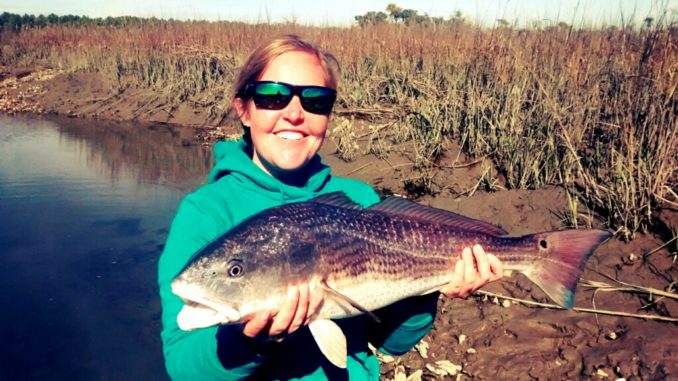
Charleston woman keys on isolated tidal pools where fish are trapped on low water
With winter redfish often moving as far back as they can in creeks to avoid predation from porpoises, they sometimes find themselves trapped in little backwater pools by the receding tide.
Darcy Hill, a Virginia native who moved to South Carolina, has been fishing the waters around Charleston for eight years, and she’s learned to target fish in areas that a fisherman with a big boat might have a difficult time reaching.
This time of year, Hill targets redfish that are stuck in pools behind oyster beds when the tide is at dead low. She said many of these stranded fish are in schools whose numbers range anywhere from 15 to more than 100 fish, and it’s not uncommon for her to have 20-plus fish days, with most reds between 15 and 32 inches.
Hill suggests using a canoe or kayak to paddle well back in the creeks as the tide is receding.
“The best thing is a kayak. Boats cannot get to the spots that I fish,” said Hill, who fishes with a medium-action Kastking spinning rod mated with a Kastking Blade 300 reel spooled with 15-pound braid.
Hill packs a variety of baits to use when she’s fishing from oyster beds, including Z-Man swim baits and purple Trout Tricks; she fishes them on a Ralph Phillips jighead. She will also bring live mud minnows or cut mullet to use on those days when artificials don’t seem to be doing the trick.
She stresses that knowing the tides is one of the most important factors when fishing from oyster beds. There will only be about an hour where fishermen will have access to oyster beds and the fish that are trapped behind them. The most productive time for her to catch fish is the hour after low tide with the tide beginning to rise.
“You definitely want to arrive during and fish the last couple hours of the outgoing tide,” she said. “Any fish trying to leave will be spooked back into the pool if they try to leave for the main creek.
“The most productive fishing is an hour after low tide, and fish the incoming tide.”
Hill stressed the importance of packing a good pair of rubber boots with think souls when you fish from oyster beds.
“My pair of boots have deep cuts after a day of fishing because the oysters are as sharp as razors,” said Hill, who advises fishermen to bring a pair of polarized sunglasses to help see the schools of reds.
Most of the fish she targets will be in a foot of water or less. She typically casts to the middle of the school, and more often than not, one of the fish will be hungry enough to pick up the bait.
Hill said fishermen can do plenty of scouting before ever getting on the water.
“Use Google Maps to locate oyster beds and deep pools of water,” she said. “It will save you countless hours that you could be fishing. Just don’t give up; persistence is the key to finding and locating fish.”



Be the first to comment